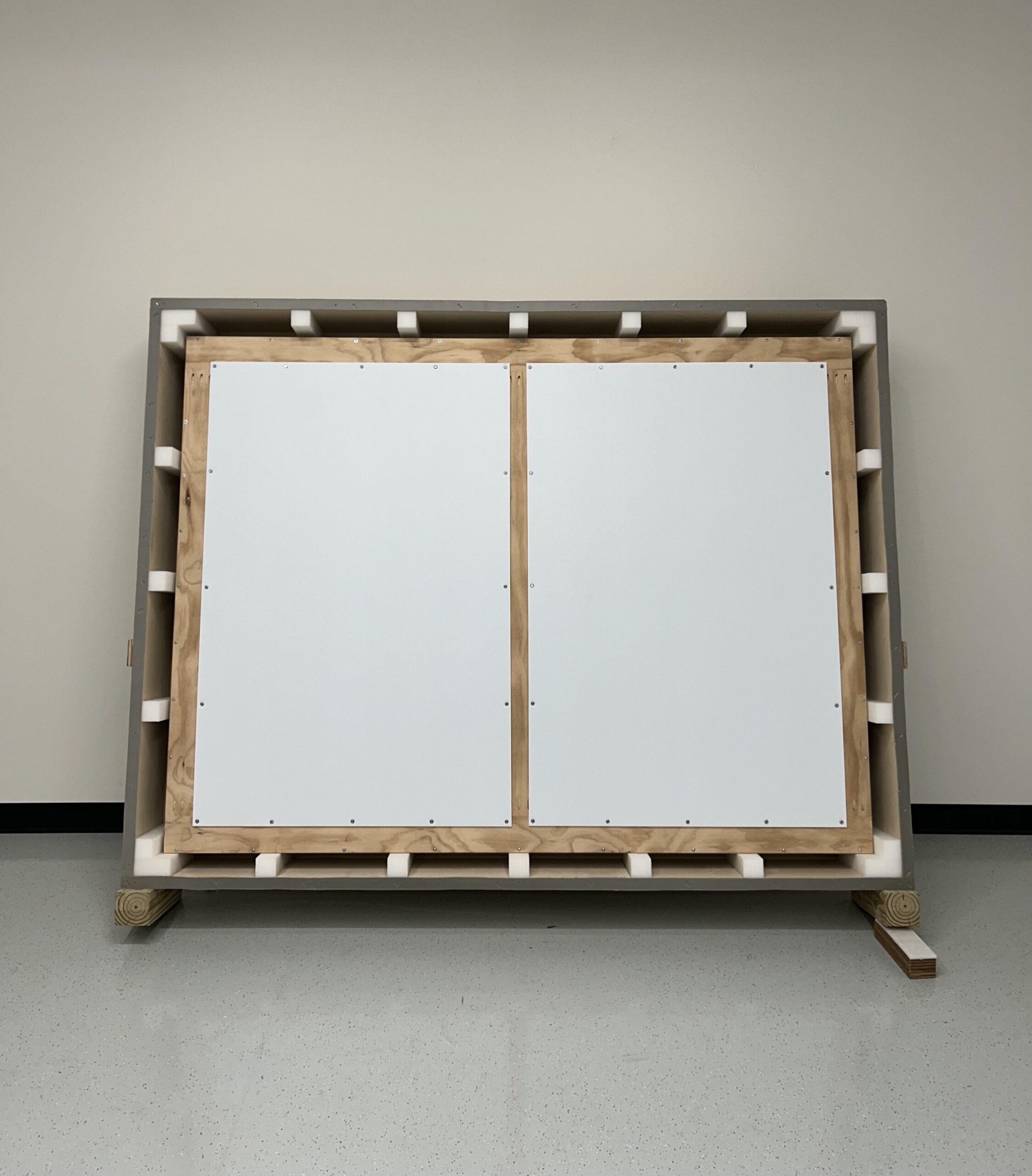All About Fine Art Crates
Deciding how to pack your art for transportation can be crucial to ensuring the safety of your artwork. Here is a deep dive into crates and why you should consider utilizing them.
CRATES VS BOXES
When packing your own art, using classic shipping boxes can be a very attractive choice. In certain circumstances, especially when a fine art shuttle is involved, boxes or soft packing can be a good option. They are affordable, light, and easy to move. But they do not provide proper safety and structure for most high value items, especially when using a traditional shipping company. If you are planning to ship a piece, we recommend building a custom crate for the work.
TYPES OF CRATES
There are several crate options available on the market. Here is a breakdown of the most common ones you will find.
Travel Frames
Travel Frames, commonly referred to as T Frames, are like a skeleton of a crate; they are not fully enclosed. They provide a simple structure for temporary moving. T Frames are nice when moving large pieces a short distance. You can drill handles into the side without damaging the piece. They are more affordable depending on the size. However, T Frames have a simple structure so, they do not make a good long term solution.
One Way Crates

One way crates are the most simple and economical form of enclosed crates. They are usually made with plywood sides/lids. One way crates will have foam protection for your artwork on the inside, and handles for easy movement. While they are typically meant for a single-trip, one-way crates can sometimes get multiple uses and are good for storing.
Standard Crates
Standard Crates, or Two-Way Crates, are a great option for art and objects that are especially fragile that require a crate for repeated use, travel, long term storage, and/or safety. Standard crates have an especially sturdy construction. They are composed of thicker, framed plywood sides that are reinforced with battens, and have integrated handles as well as skids. Inside, you will find foam supports to perfectly fit your piece and a foam gasket under the lid.
Museum/International Crates
Museum crates are the highest quality and durability you can get in a crate. They will last a very long time and are meant to protect high value works during frequent trips. These can often be found at a traveling show. Museum crates typically have all of the features found in a standard crates, but will often be bolted and plated closed, have an outer sealant for water protection, and glued and screwed joints. Their durable method for building withstands repeated use while keeping the crate looking pristine over time.
FEATURES
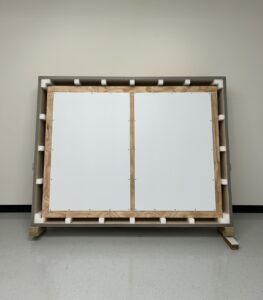
There are certain features that you can add to your crate to make it more custom to your needs. Foam used for support inside the crate will help with support as well as shock absorption. Ethafoam is often used for its archival purposes. It will float the artwork away from any surfaces that could damage the work or its glazing. Pieces will also be wrapped in Poly inside the crate to ensure it remains completely free of moisture or particles.
You can specify the type of handle you would like, whether it’s integrated or an added metal part. Oz clips can be added to support your piece inside the crate.
Each crate has a stencil design on the outside showing shippers that it’s fragile, to keep it dry, and which side to keep up. A label will also be added to ensure that if anything goes wrong, information about what’s inside the crate is clear and that it gets to where it needs to go.
ARTSERVE’S CRATES
Each of our crates are custom built to optimize the safety of your items based on their needs. We will work directly with you to make your piece as safe as possible. We will “dry fit” your piece into the crate before shipping to ensure the fit is perfect. Our crates are made in-house by our very experienced fabricators. Their expertise in the art field, as well as being artists themselves, ensures that your artwork is packed the best that it can be. If you are interested in a fine art crate, contact us and we’ll give you an estimate to match your needs!
Dealing With High Value Items During Moving & Renovations
If you are moving to a new apartment, home, or your place of living is going through renovations, odds are your high value items, like fine art, will need to be protected and moved too. These items can be tricky to deal with due to value or fragility. Consider the following for your next steps:
COMPILE A LIST
This may sound straight forward, but if you have a lot of items, the more information you have on them the better! Here are some points to include in your list:
Estimated Dimensions, Artist, Title, Date
Information specific to each item is the most important. Some pieces don’t have their information written/attached to them; compiling all the information you have on a list will guarantee it doesn’t get lost. Your piece’s provenance will identify what is what. Providing specific information like dimensions will allow professionals to have a better idea of what they are dealing with. Having this list is also a great reference for you when trying to remember what you have and what was moved.
Value
How much is your piece worth? How much sentimental value does your piece have? This information is good to know to determine how much care you wish to be given to your items.
On Site Location
Where is your piece located in your home? When you have many pieces, often the location can get mixed up. It is helpful to know just where each piece is, especially if it is being professionally handled.
Insurance
Do your items have insurance? If your artworks are leaving their resting place during moving, damage is a lot more likely to occur. It is important to note if your pieces have insurance just in case.
HIRE PROFESSIONAL HELP
Professional art handling companies, like A2//Artserve, are expertly trained to deal with your artwork & high value items. Their expertise can be invaluable when safely packing and transporting your work. Oftentimes, professionals will schedule a site visit before anything happens. They will begin compiling a list of their own using the information from your original list. Then, they will begin taking images of your work and making sure all pieces are accounted for in reference to the list.
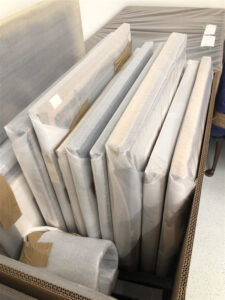
Come moving day, they will wrap your items with foam and poly to protect them from the elements and transport them to a safe place for temporary storage. They will know how best to organize your work. When it comes time to move back in, they can also put it back exactly where it came from based on their initial reference images.
ART STORAGE
When big life events are happening like moving or renovating, you will want a safe place to put your high value art & items while you wait to move back in. Art handlers, like Artserve, can move your work to an Art Storage facility, like A2 Art Storage, for a safe and temporary “home away from home”. After your work comes in for temporary storage, your work can be inventoried so that everything is accounted for. Here is another blog post where we dive into inventory and its importance when storing artwork.
A2 is proud to announce our official partnership with Artserve!
So, you may have noticed some changes around here… In June 2023, A2 Art Storage & Services acquired Artserve, and we are proud to announce our partnership! Artserve has been leading the fine art handling business in our Twin Cities community since 1994. Artserve continues to provide a full range of museum-quality services including installation, crating, transportation, framing, and design. We are overjoyed to be able to now provide a full range of services accounting for all of one’s art needs!
It’s business as usual in both of our locations, just with added accessibility to both A2 and Artserve’s services for our customers’ convenience!
As the Twin Cities’ art community continues to grow, we will grow right along with it.
With Love,
A2 // Artserve

What makes an object need full climate control storage?
Climate Controlled Storage
Storage facilities that are climate controlled, like A2 Art Storage, control the Relative Humidity and temperatures throughout their facilities. In any region where the elements naturally fluctuate, one’s personal valuables that require special care could be negatively affected. It is important to consider the needs of your object when finding suitable storage solutions near you.
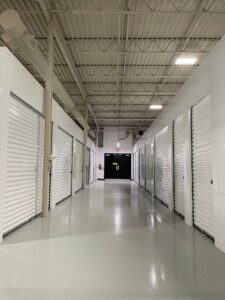
Relative Humidity
Relative Humidity (RH) in any space can fluctuate rapidly based on the natural elements. This can cause stress on objects. If an RH is too low, it can be too dry for objects and embrittle certain materials. Too high of an RH can create mold growth and corrosion of metals due to thick moisture. Maintaining the perfect amount of moisture in the air is vital to the survival of precious items, i.e. fine art.
Temperature
Temperature fluctuations are most likely to affect the “natural aging” of objects. Cooler temperatures tend to help preserve materials. However, too cold and materials like wax or plastic can freeze and break. Too hot, and those same materials can melt. High temperatures will speed up natural chemical deterioration and in conjunction with RH, can begin natural degradation.
Objects that would benefit from climate controlled storage
When considering climate controlled facilities, like A2, here are some examples of objects that typically benefit from such care.
-
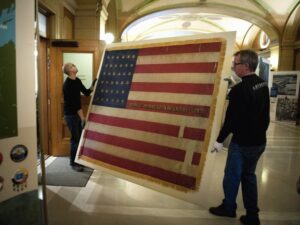
Artserve moving fragile American Flag piece. Photo by Glenn Stubbe, 2012 Art: Artwork can contract or expand with changes in humidity and temperature.
- Electronics: If maintained in an unsuitable environment for a long time, electronic devices, i.e. circuiting components, will mold or oxidize.
- Fabrics or papers: Delicate fabrics or papers can mold in humid environments, while excessive temperatures can cause paper to discolor.
- Vinyl: The risk of warping increases with varying temperatures, whereas the chance of breaking increases with decreasing temperature.
- Antique wood or metal items: All metals will oxidize and change color in response to moisture. Wood will expand and contract in response to temperature, making it vulnerable to rot and mold.
Degradation and Signs You Should Consider Protecting Your Art
Art comes in all different shapes and sizes. With this comes a variety of practices for keeping your art safe and protected from the elements. If you don’t know what to look for as signs of degradation, the art could become compromised without even knowing. Here is some classic evidence of degradation and signs you should have a professional look into protection:

Paintings
Loss of gloss or color. Chalkiness or peeling. Oftentimes, UV light or a smoky environment can change your piece over time.
Sculpture
Glue discoloration, or paint degradation. Corrosion in metal, sometimes resulting in patina. Decomposition of materials due to climate, odors.
Fiber Arts
A fibers’ color can change due to the dye and age, but sometimes it also changes due to sun and climate. Texture of fibers changing. Crusty, crunchy, or breaking of fibers. Decomposition.
Paper Mediums
Acids and acidic materials (ex. Cardboard) can cause pieces to deteriorate. Discoloration, reddish brown spots. Mold or musty smell. Flaking, crumbling, or breaking of paper fibers.
When considering if your piece is safe from degradation or not, it may be worth considering its options. If you would like to find restoration, look into transportation services and art handlers, like our sister company, Artserve, to transport. Similar to the services we offer at A2, valuable art work requires professional handlers with expertise to handle with the upmost care. Here are some questions you should ask yourself:
Where will your valuable work end up after you’ve successfully restored or protected your work?
How will you ensure its safety after it has found its resting spot?
Storage is a very good option! Temporary storage or not, art storage facilities typically have climate/humidity control and other amenities that will ensure the longevity of life for whatever your piece needs.
If your piece returns home, and you are worried about the conditions your home provides for the piece, consider the aforementioned signs and contact your art handlers for further steps to be taken.

